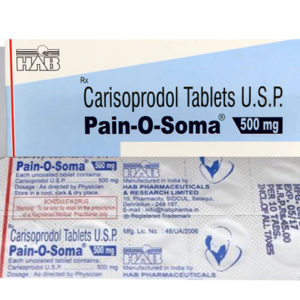Description
Tramadol combats pain
Tramadol is a painkiller that is used to control medium and severe pain. However, the drug combats only the symptoms but not the cause of pain. Tramadol there are both in the form of tablets, drops and suppositories, as well as injections and infusions. Just like other painkillers Tramadol also has side effects: should note particularly one, – even if this side effect is relatively rare – that the regular intake of Tramadol may cause dependence.
Tramadol: Action against pain
Tramadol belongs to the group of opioid analgesics. The main active ingredient of this group is morphine. Opioids analgesics are used to treat moderate and severe pain – pain weaker hand treated with non-opioid analgesics such as acetaminophen or aspirin.
For moderate pain weaker opioid drugs such as tramadol or tilidine are used. For severe pain contrast stronger opioids such as morphine, fentanyl and Burprenorphin be used. Compared to morphine, the effect of tramadol is approximately four times weaker – but the mode of action of the two substances is very similar.
After taking Tramadol produces its effect in the brain by binding to opioid receptors there. These receptors normally act endogenous messenger substances that inhibit pain perception. Tramadol is similar in structure to those messengers and can thus bind to the opioid receptors. That’s why after taking even relatively severe pain are only perceived as low.
Affect the perception of pain
In addition, tramadol has still a second mechanism of action: The drug inhibits the brain namely the reuptake of serotonin and norepinephrine, and increases in this way affect the perception of pain. In this regard, tramadol similar to some antidepressants such as the tricyclic antidepressants.
The effect of tramadol uses approximately 30 minutes after taking the painkiller. Depending on the ingested dose and the severity of the pain adhere to the analgesic effect between two and seven hours. The individual dose of tramadol is calculated by the attending physician depending on factors such as the degree of disease, the perceived pain intensity and the age and weight.
Side effects of tramadol
As with the other active ingredients from the group of opioid analgesics also taking Tramadol is associated with side effects. The most common side effects include nausea and dizziness. Likewise, there may be headache, dizziness, dry mouth, vomiting, constipation and sweating after taking often.
Occasionally the painkillers also has effects on the cardiovascular system: It can have side effects such as palpitations, increased heart rate, cycle fluctuations or circulatory collapse occur. Similarly, there may be occasional diarrhea, rash and itching. Only rarely occur after use of tramadol contrast to side effects such as disorders of the respiratory, blood pressure, hallucinations, confusion, and changes in appetite.
Risk of dependency low
Also rare are the cases in which the intake of Tramadol causes addiction. To a dependency occurs especially when the drug is taken over a longer period. However, even after a prolonged ingestion is the risk of becoming dependent, relatively low. If there is a dependency, can withdrawal symptoms such as sweating and freezing, as well as gastrointestinal discomfort after the end of treatment.
Before taking the painkiller, you should be informed in any case, consult your healthcare provider or pharmacist about possible side effects and read the leaflet carefully.
Tramadol: contra indicators and interactions
Like all other drugs should not be used even tramadol if a hypersensitivity to the substance is present. In addition, the Schmermittel must not be used when pre-alcohol, psychotropic drugs, sleeping pills or other painkillers were taken because the substances can reinforce each other in their mode of action. Another contraindication also represents taking MAO inhibitors within the last two weeks, since it can otherwise lead to serious side effects.
Epilepsy should – especially if the disease is not under control – no need to stop taking Tramadol. Because regularly and taken in higher doses, the drug can increase the risk of an epileptic fit. In addition, it should be noted that the epilepsy carbamazepine medicament decreases the efficacy of tramadol.
Furthermore Tramadol should not be combined with agents that lower the threshold for seizures. These drugs, among other tricyclic Antidepepressiva and selective serotonin reuptake inhibitors. In combination with the latter can occur in rare cases, serotonin syndrome.
Caution in hepatic or renal function
Likewise Tramadol should not be used if blood thinning drugs are taken, since the drug also has an effect on blood clotting. Even when taking the fungal agent ketoconazole and the macrolide antibiotic erythromycin should be avoided taking Tramadol.
If there is a limited hepatic or renal impairment, tramadol should only be taken after consultation with the attending physician. The same applies to impaired consciousness, in disorders of respiration, in states of shock and in disorders of the brain and increased intracranial pressure.
In patients in whom a hypersensitivity to opioids is present or prone to drug abuse, tramadol should also be applied only after a detailed consultation with the attending physician. Not recommended the painkiller is a substitute drug for people who are dependent on opiates, because it can not cover the withdrawal syndrome.


Reviews
There are no reviews yet.